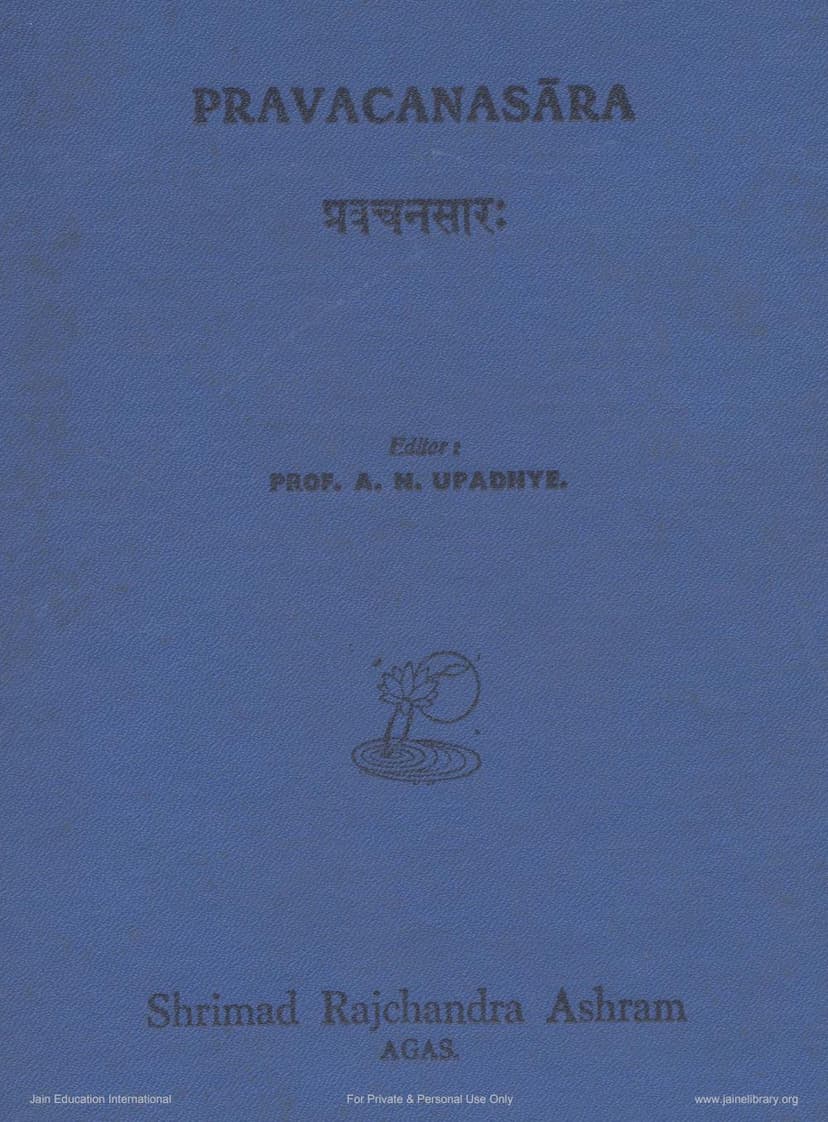Pravachanasara
Added to library: September 2, 2025

Summary
This is a comprehensive summary of the provided Jain text, "Pravachanasara," based on the table of contents and the introductory sections, aiming to capture the essence of its structure and philosophical content as presented in the translated English portions.
Book Title: Pravachanasara (Pavayanasara) Author: Sri Kundakundacharya Publisher: Shrimad Rajchandra Ashram (Part of the Parama-Shruta-Prabhavaka Shrimad Rajchandra Jaina Shastramala) Publication Year: 1964 (Third Edition)
Overall Nature of the Text: Pravachanasara is a significant pre-canonical text of Jainism, considered a foundational work alongside Pañcāstikāya and Samayasāra, collectively known as the "Nātaka-traya" or "Prābhrta-traya." It is revered by both Digambara and Śvetāmbara Jain traditions. The text is primarily in Prakrit, with extensive Sanskrit commentaries and a Hindi commentary included in this edition, alongside an English translation. It delves deeply into Jain philosophy, ethics, and the path to liberation.
Key Focus and Themes: The book's title, "Pravacanasara," signifies "The Essence of the Doctrine." It aims to impart the core teachings of Jainism, particularly focusing on the spiritual path and the ultimate nature of reality. The text is noted for its emphasis on Niscaya Naya (The Real Perspective), while also explaining Vyavahara Naya (The Conventional Perspective) to aid understanding.
Structure and Content: The edition by A. N. Upadhye is a scholarly work, offering a critical analysis of the text, its author, and its philosophical dimensions. The Introduction (an exhaustive essay) covers:
-
Sri Kundakundacharya:
- General Appreciation: Kundakundacharya is considered a highly authoritative and revered figure in Jainism, second only to Mahavira and Gautama. His works are foundational for both Digambara and Śvetāmbara traditions.
- Traditional Names: Discusses various names attributed to him, including Padmanandi, Kondakunda, Vakragriva, Elacharya, and Grdhrapiccha, critically evaluating the evidence for each.
- Date: A significant portion of the introduction is dedicated to determining Kundakunda's date, exploring traditional accounts, epigraphic evidence, and scholarly debates, generally placing him in the early centuries of the Common Era.
- Works: Details Kundakunda's prolific output, particularly the eighty-four Prahudas (treatises), and analyzes key works like Satkhandagama-tika, Mulācāra, Ten-Bhaktis, Damsaņa-pāhuda, Căritta-pāhuda, Sutta-pāhuda, Bodha-pāhuda, Bhāva-pāhuda, Mokkha-pāhuda, Linga-pāhuda, Śīla-pāhuda, Rayanasāra, and Bārasa-Aṇuvěkkhā, Niyamasāra, Pañcāstikāya, and Samayasāra. The commentary discusses the contents, philosophical aspects, and potential authorship issues of these works.
- Commentators: Provides monographs on prominent commentators of Pravacanasara, including Amṛtacandra (Tattvadipika), Jayasena (Tatparyavrtti), Balacandra (Kannada Tatparyavrtti), Prabhacandra (Sarojabhaskara), Mallisena, and Pande Hemaraja (Hindi Balavabodha).
- Prakrit Dialect: An in-depth analysis of the Prakrit dialect used in Pravacanasara, discussing its features, classification, and relation to other Prakrit dialects, identifying it as "Jaina Sauraseni."
-
Pravacanasāra:
- Study of Pravacanasara: Its significance in Oriental studies and previous scholarly work on the text.
- The Text: Discusses textual criticism, recensions, and the nature of additional verses found in manuscripts.
- Summary of Pravacanasāra: A detailed breakdown of the content across its three Books, covering:
- Book I: Focuses on the concept of Suddhopayoga (Pure Consciousness/Effort) as the means to liberation, contrasting it with Subhopayoga (Auspicious Effort) and Aśubhopayoga (Inauspicious Effort). It elaborates on the nature of Omniscience (Kevala Jnana), describing it as an intrinsic quality of the liberated soul, characterized by pure, direct, and all-encompassing knowledge and bliss, free from sensory or temporal limitations. It also touches upon the non-dual nature of the liberated self.
- Book II: Delves into the Jaina ontology, explaining the concepts of Substance (Dravya), Quality (Guna), and Modification (Paryaaya). It details the six substances (Jiva, Ajiva, Pudgala, Dharma, Adharma, Kala) and their characteristics, the atomic theory (paramāņu), and the nature of Syadvada (the doctrine of conditional predication) and Nayavada (the theory of viewpoints) as tools to understand the multi-faceted reality. It contrasts Jaina ontology with other Indian philosophical systems like Samkhya and Vedanta.
- Book III: Primarily focuses on Monasticism (Charitra) and the ideal conduct of a Jain monk. It outlines the strict ascetic practices, the importance of internal purity over external rituals, and the commitment to non-attachment and the eradication of passions. It also discusses the Jaina conception of Divinity as the liberated soul (Svayambhu), attained through self-realization, rather than a creator deity.
Key Philosophical Concepts Discussed:
- Niscaya Naya vs. Vyavahara Naya: The fundamental principle of understanding reality from the ultimate perspective (soul's intrinsic nature) versus the conventional or practical perspective.
- Suddhopayoga: Pure consciousness, the direct experience of the soul's true nature, leading to liberation.
- Omniscience (Kevala Jnana): The intrinsic, unhindered, and all-encompassing knowledge of the liberated soul.
- Dravya, Guna, Paryaaya: The Jaina metaphysical framework explaining reality as substances (dravya) possessing qualities (guna) which manifest as modifications (paryaaya).
- Syadvada and Nayavada: Methodologies for understanding the complex, multi-faceted nature of reality and the limitations of language and human perception.
- Anekanta-Vada: The doctrine of manifoldness, the idea that reality has infinite aspects.
- Karma: The subtle matter that binds the soul and causes its transmigration, and the path to its annihilation.
- Conception of Divinity: The Jaina view of divinity as the perfected, liberated soul (Svayambhu), not a creator God.
- Asceticism: The rigorous ethical code and practices for monks, emphasizing detachment, non-violence, and self-control.
In essence, Pravacanasara, as presented in this scholarly edition, is a profound exploration of the Jain path to spiritual liberation, illuminating the intrinsic nature of the soul, the principles of the universe, and the ethical disciplines necessary for achieving the highest state of existence.